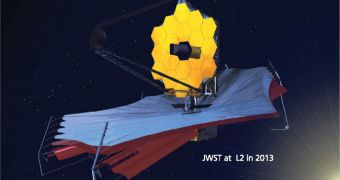Even with the help of large space telescopes, we might never find the answers to some of the most intriguing mysteries of the universe. Though mankind has a number of space telescopes in the close orbit of the Earth, scientists want even more powerful tools to make detailed observations of the universe, to build better models that would fully explain the galaxy formation process, or to understand the mysteries related to quasars and black holes.
The biggest space telescope so far will be launched in 2013 by NASA and will have a segmented mirror with a total diameter of 6.4 meters, meaning it will have a light collecting surface area about seven times that of the famous Hubble space telescope. The James Webb Space Telescope, with its high resolution will be able to see further back in time, to observe objects that now look to the other space telescope like fuzzy blobs of light.
By being able to see further back in time, JWST will have the capability of viewing galaxies billions of years into the past, to observe the arms filled with stars of spiral galaxies and learn how some types of galaxies evolved, enabling astronomers to rapidly expand the scientific knowledge.
However, the launch of the NASA's largest space observatory is not the only big idea some astronomers have. An astronomer and project scientist for several of NASA's missions, Wes Traub proposes a planet-finding mission, to find extrasolar planets in greater detail. The idea is to block the blinding light emitted by the galaxy and stars with giant occulter or "solar shade", to observe planets in the orbits of other stars with the help of future space telescopes.
He argues that even if the image of a distant planet would consist of only one pixel, the astronomers would still be able to describe the surface of the planet, its size and even if it has life or compounds that would encourage life to appear such as water, oxygen or methane, just by studying the light reflected from the planet's surface. Even though the JWST has a big sensitive mirror and it only has a camera detector the size of a postage stamp, it might just be able to take such measurements.
Nevertheless, Traub says he would like to see even bigger space telescopes to study distant extrasolar planets. The capability of observing further objects in greater detail grows proportionately with the diameter of the reflective mirror equipping the space telescope, thus allowing for faster observation of distant objects.

 14 DAY TRIAL //
14 DAY TRIAL //